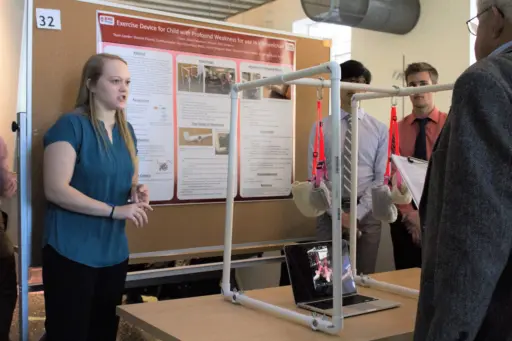Patient-removed IUDs, virtual reality pain management, and a thyroid exam simulator: all part of a day’s work in BME design.

On Friday, Dec. 8, 2017, undergraduate students in the Department of Biomedical Engineering (BME) at the University of Wisconsin-Madison gathered to showcase the fruits of a semester’s labor: 61 unique healthcare solutions for 61 unique client problems were on display at the biannual design poster session.
“It was incredible to see this semester’s work come to fruition in our biggest and most diverse design poster session ever,” says John Puccinelli, associate chair of the undergraduate program. “I say this every year, but the students continue to impress more and more.”
Since 1998, teams of BME undergraduates enrolled in the major’s six-semester design curriculum have paired with representatives of campus, medical corporations, and the Madison community in search of innovative healthcare solutions. They’re tasked with developing (or improving) a prototype by the end of the semester.
The versatility of the biomedical degree allows prospective clients to submit project ideas from a spectrum of medical specialties ranging from oncology to obstetrics. In the case of senior Savannah Kuehn and her team, their automatic intraventricular drainage system was designed to assist Joshua Medow, a professor of neurosurgery in the UW School of Medicine and Public Health, in pursuit of a less complicated process for draining cerebrospinal fluid in patients with increased intracranial pressure.
“I think it’s interesting that students at our age are able to delve into a project and figure it out on our own,” says Kuehn.

She describes her team’s creation not as a class project, but as the product of a mutually beneficial partnership: the students sharing their eye for design with Medow; he sharing his knowledge of neuroscience and fluid dynamics.
This chance to apply classroom theory to real-world problems is something that junior Bobby Weishar and his teammate, sophomore Jessica Zola, have come to value this semester after working with Randall Kimple, an assistant professor of human oncology, to create an alternative method to measure tumor volume in mice involving water displacement and sensors. “It’s a lot different from a homework assignment that you turn in and never see again,” says Zola. “You can have an impact.”

Indeed, many BME designs have evolved into successful spinoffs and start-up companies; in April 2017, for example, two BME graduates and co-founders of EnsoData received approval from the Food and Drug Administration for an automated sleep analysis product. The technology will help doctors more efficiently treat patients with sleep disorders—a population the American Institute of Sleep Medicine estimates to be as large as 50 to 70 million.
Other designs have a more immediate, personal effect: Current junior Desiree Fluoro and her team spent the semester with 10-year-old Aubrey, a patient with the genetic condition spinal muscular atrophy (SMA) type 1, and her physical therapist, Karen Patterson. The two came to Fluoro and her team with a paradox: though SMA had destroyed Aubrey’s motor neurons (interrupting her muscle communication and immobilizing her), to be eligible for two new gene therapies, she needed to demonstrate substantial muscle development. After a few field trips to the hardware store, the team delivered a PVC-pipe exercise device to Aubrey’s home, fashioned to elevate and swing her legs gently from her wheelchair to increase the strength in her legs.
“The look of happiness on her face was amazing,” says Fluoro.
The novel mix of community, industry, and academic experiences that the BME design curriculum fosters is incomparable—and, as one visitor said at the closing of the expo, “the most innovative work in the College of Engineering.”